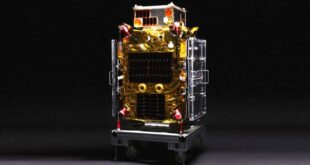
Earth observation satellites play a key role in weather forecasting, climate research, monitoring of the planet’s surface and the detection of forest fires. These tasks require satellites to transmit very large amounts of data to the ground for analysis. Today’s radio systems are reaching their limits in this area.
Optical transmission methods, however, offer the possibility of sending data at significantly higher rates. The first transmission tests have now been carried out using the Optical Space Infrared Downlink System (OSIRIS) laser communications terminal, which was developed by the German Aerospace Center (Deutsches Zentrum fur Luft- und Raumfahrt; DLR). The terminal is located on board the ‘Flying Laptop’, a small satellite developed by the University of Stuttgart.
The OSIRIS laser terminal
OSIRIS is extremely compact, weighs only 1.3 kilograms, and is very power efficient. Successful transmission tests have now been carried out using DLR’s optical ground station in Oberpfaffenhofen as part of a programme of experiments that has been ongoing since the summer of 2018.
These results were confirmed during a measurement campaign conducted in March 2019, when the laser beam from the Flying Laptop was received on the ground. The high-precision alignment of the satellite and ground station with one another represents a particular challenge, and has now been demonstrated for the first time.
“The transmission of satellite data by laser is the future,” says Florian David, Deputy Director of the DLR Institute of Communications and Navigation.
“The power of optical communications will make it possible to, for example, make far larger amounts of data available to rescue workers on the ground during disaster recovery operations.
For this reason, optical communications is a key area of our research.” As part of the OSIRIS programme, the DLR Institute of Communications and Navigation in Oberpfaffenhofen is developing optical communications systems that are particularly suited to direct downlink from small satellites.
The ‘Flying Laptop’ small satellite
The University of Stuttgart’s ‘Flying Laptop’ small satellite is testing new technologies and assisting with scientific Earth observation. In addition to numerous experiments, the satellite is also equipped with a high-resolution camera.
The satellite, which was developed and built by students and doctoral candidates as part of the Small Satellite Program at the Institute of Space Systems, was launched from Baikonur in 2017.
The programme was initiated by Hans-Peter Roser and supported by experts from space research and industry. The operation of the satellite and the scientific evaluation of the data are funded by a grant from the Baden-Wurttemberg Ministry of Science, Research and the Arts.
“Although laser data transmission offers huge advantages in terms of achievable data rates, it also poses a tremendous challenge when it comes to accurately aligning the satellite with the ground station. The successful OSIRIS transmission tests demonstrate the high precision of the attitude control system and our satellite’s outstanding performance,” says Sabine Klinkner, OSIRIS Project Leader at the University of Stuttgart.
Following the success of the transmission tests, the research teams in Stuttgart and Oberpfaffenhofen are keen to carry out more experiments with OSIRIS on the Flying Laptop. These include the reception of mission data and the characterisation of the transmission channel.
This should make a vital contribution towards international standardisation of the technology and enable the development of even more robust transmission processes for future missions. The experiments will continue in Oberpfaffenhofen from spring 2019.





